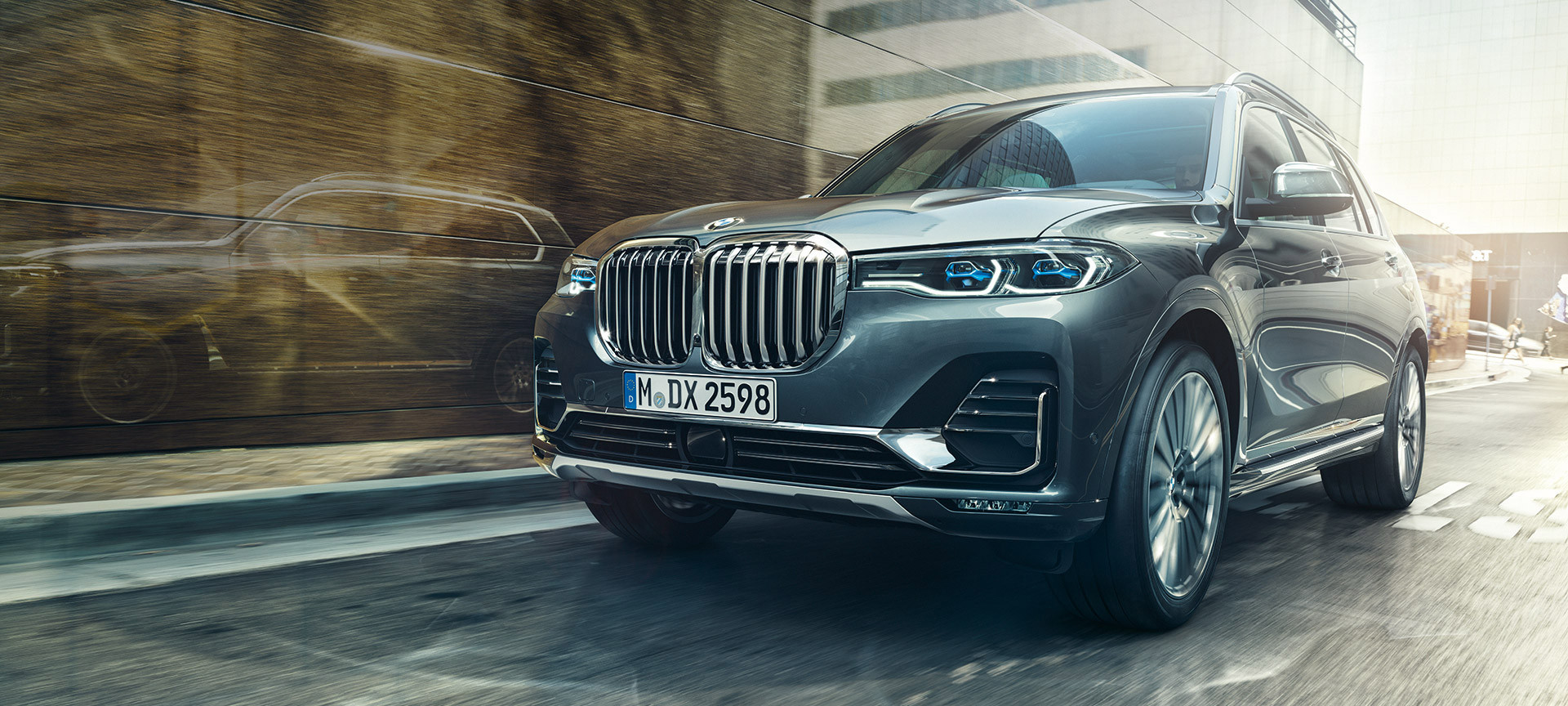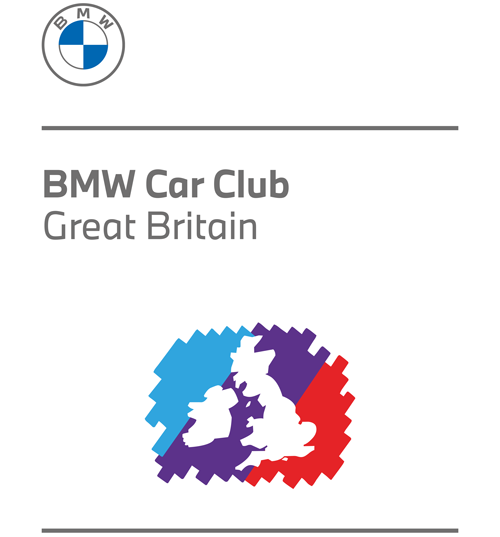BMW is set to redefine automotive luxury with the new X7 model, the latest flagship of the BMW X-line-up. This latest 4×4 offers exclusivity, spaciousness, superior quality, strong performance, agile handling and off-road capability.
It is the largest model in the BMW X line-up combining outstanding powertrain and chassis technology as well as practicality and versatility. With three rows of seats, the interior of the BMW X7 is a paragon of quality, delivering outstanding luxury and a full complement of advanced equipment features.
Exterior design
The new BMW X7 is 5,151mm long, 2,000mm wide and 1,805mm tall, with a wheelbase of 3,105mm. In terms of design, the BMW X7 has a three-dimensional version of the bar that turns upwards at its outer edges. At the front, Adaptive LED headlights and front foglamps are standard, while BMW Laserlights are optional. This system employs a spotlight with Selective Beam delivering a non-dazzling high beam range of 600 metres.
Viewed from the side, the BMW X7 features clearly structured surfaces and a character line that rises up to the rear end and it is these elements that are part of the brand’s new design language. The rear doors are longer than the front doors making it even easier to get in and out. Roof rails and the chrome trim strips that run around the door sills, extend up to the Air Breathers and continue in the rear apron, are standard. Fully body-coloured wheel arches house light-alloy wheels in formats up to 22-inches.
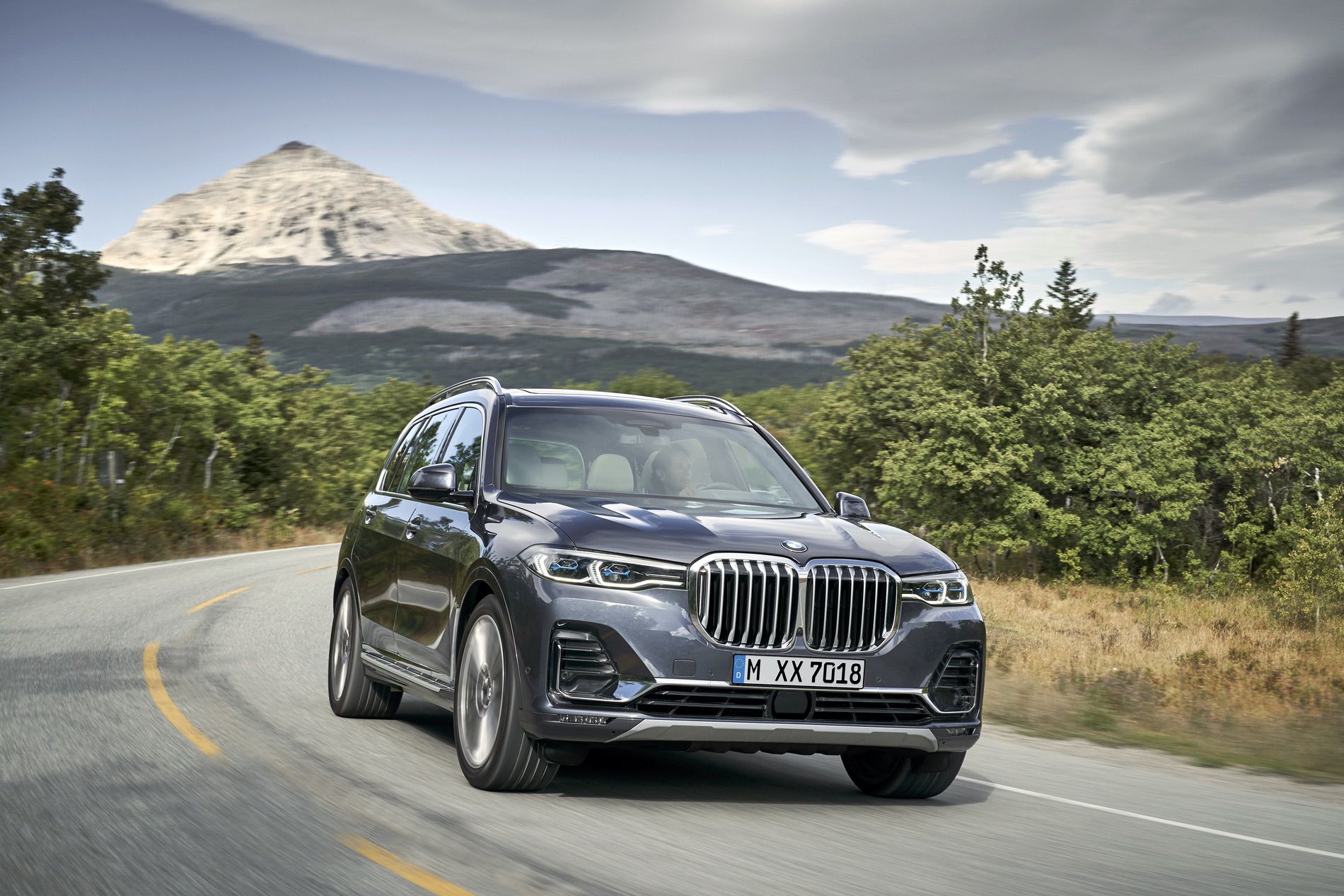 The rear is broken up by horizontal lines and bordered by vertical separating edges. Bridging the space between the slim LED rear lights is a chrome bar – a design cue that has only previously been used at the rear of the BMW 7 Series.
The rear is broken up by horizontal lines and bordered by vertical separating edges. Bridging the space between the slim LED rear lights is a chrome bar – a design cue that has only previously been used at the rear of the BMW 7 Series.
Grille bars in Aluminium Matt and an array of accents in High-Gloss Chrome, plus 21-inch light-alloy wheels in Y-spoke design, are included on the entry model as standard. The M Sport model features extra-large air intakes, M-specific 21-inch light-alloy wheels in M twin-spoke design and a distinctive look for the front apron, rear apron and side skirts. It also includes additional design elements in High-gloss Black or Black Chrome – a shade reserved for BMW’s luxury-class models.
Trim elements in High-gloss Chrome can be specified as an option, while options for the BMW Individual range include Sunstone metallic paint and 22-inch light-alloy wheels.
Interior and equipment
The interior of the BMW X7 is full of expansive surfaces, flowing lines and clear structures. Electroplated accent trips feature on the instrument panel and centre console, and the newly designed display grouping that comes as part of the standard-fitted BMW Live Cockpit Professional includes a Control Display and a fully-digital instrument cluster – each with a screen diagonal of 12.3-inches. A sports leather steering wheel is also standard.
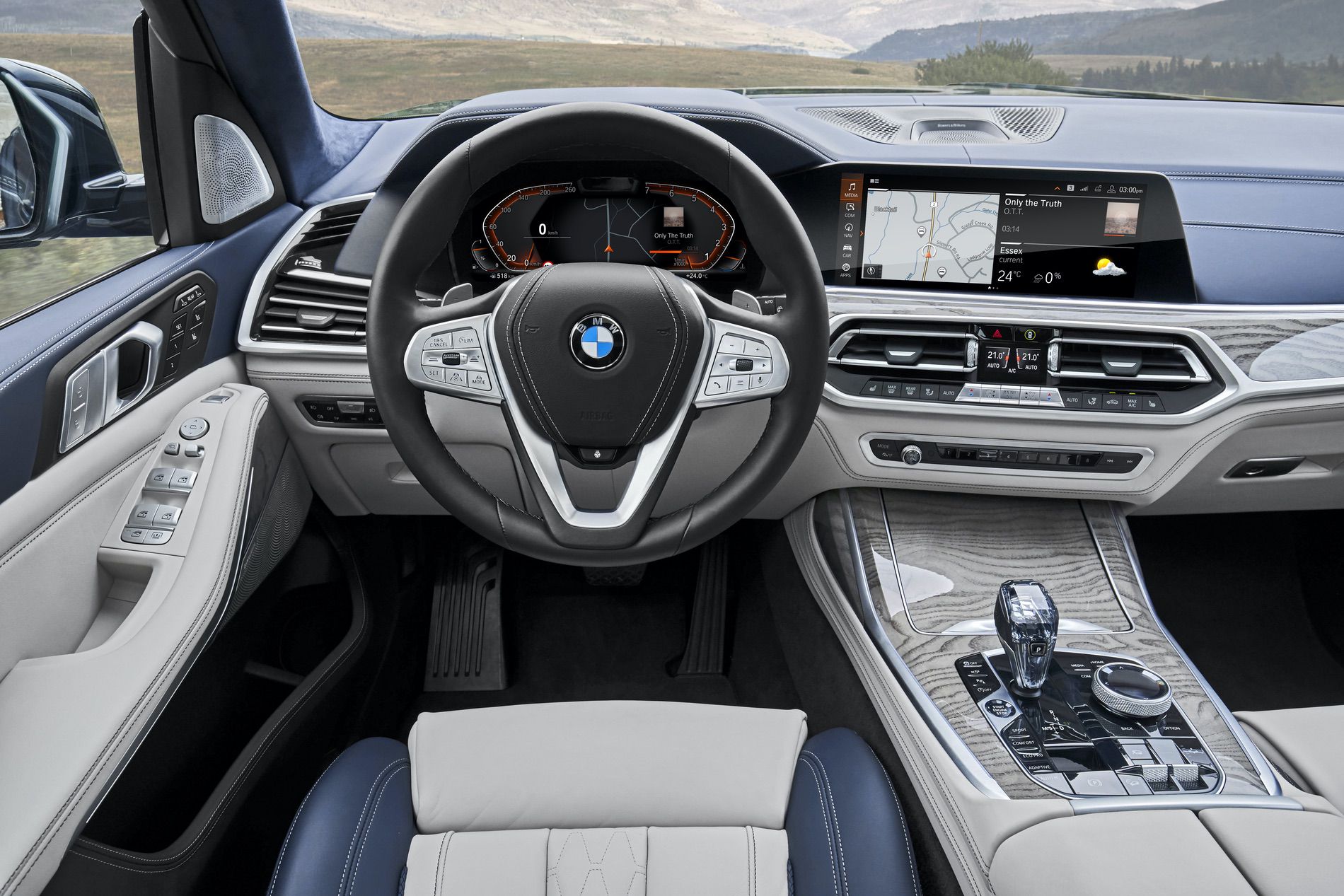
The iDrive Controller, the newly designed gear selector, start/stop button, the Driving Experience Control switch controls, electric parking brake button and the settings for the air suspension and optional off-road modes are all located in the centre console.
Light functions in the BMW X7 are operated using buttons, while the high-quality CraftedClarity glass application for the gear selector, the start/stop button, the Controller and the audio system’s volume control are available as an option.
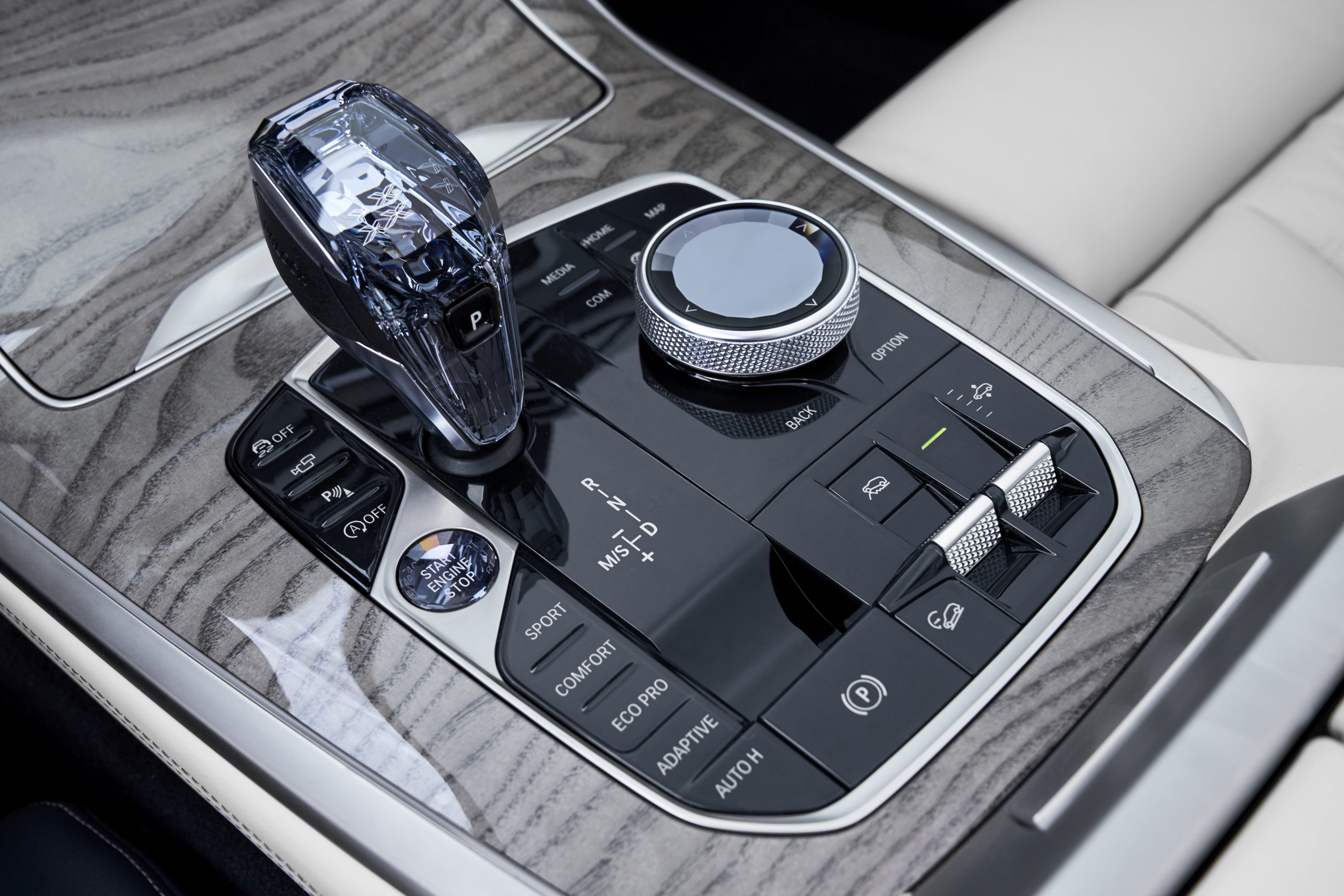
Three rows of seats; room for seven adults to sit comfortably
The BMW X7 has three rows of seats that offer space for up to seven adults. The third row has two full-size seats with space between them – a first for a 4×4. A standard-fit glass roof adds to the spacious feel while cupholders and armrests integrated into the side panel trim offer additional comfort.
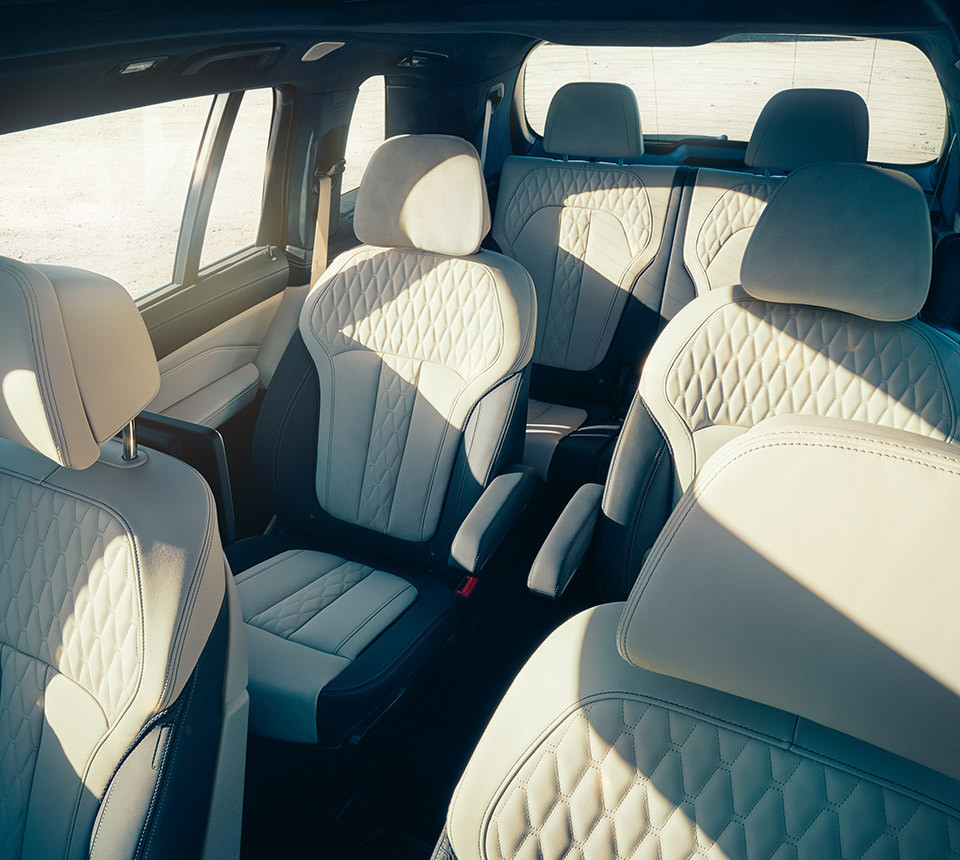
The fore/aft position of the second-row seats is adjusted using a control panel integrated into the driver’s door. Drivers can also slide both their own seat and the front-passenger’s backwards and forwards at the touch of a button. This will increase both legroom and ease of entry/exit for the passengers in the second and third row of seats, as required. From the boot, the backrests of the second- and third-row seats can also be folded down and back up again, while and the second-row seats can also be moved fore and aft.
Boot capacity is 326 litres and increases to a maximum 2,120 litres when the backrests of the seats in the second and third rows are folded down. The standard air suspension allows the car to be lowered (at the touch of a button in the boot, via the display key or rocker switch within the centre console) to make loading easier. The new BMW X7 features a two-section split tailgate, both elements of which have electric opening and closing as standard. If the optional Comfort Access is specified, the tailgate opens and closes automatically and hands-free.
The standard individual Extended Merino leather trim and optional BMW Individual full Merino leather trim are both available in five colour variants. The standard comfort seats for the driver and front passenger are heated and can be ordered with a ventilation function as an option. The seats in the second and third rows are also heated, while the front row can be specified with optional massage capability.
Standard three-part panoramic glass roof
The BMW X7 features an electrically-operated panoramic glass roof as standard. The front, central and rear glass elements all have an electrically sliding headliner activated from a control panel in the front section of the roof. If the optional electric sun blinds for the windows in the rear doors are specified, rear passengers gain a button for operating the headliner.
The Panorama glass roof Sky Lounge, meanwhile, features LED lighting spread evenly across the glass surfaces to illuminate more than 15,000 graphic patterns and generate a display reminiscent of a starlit sky.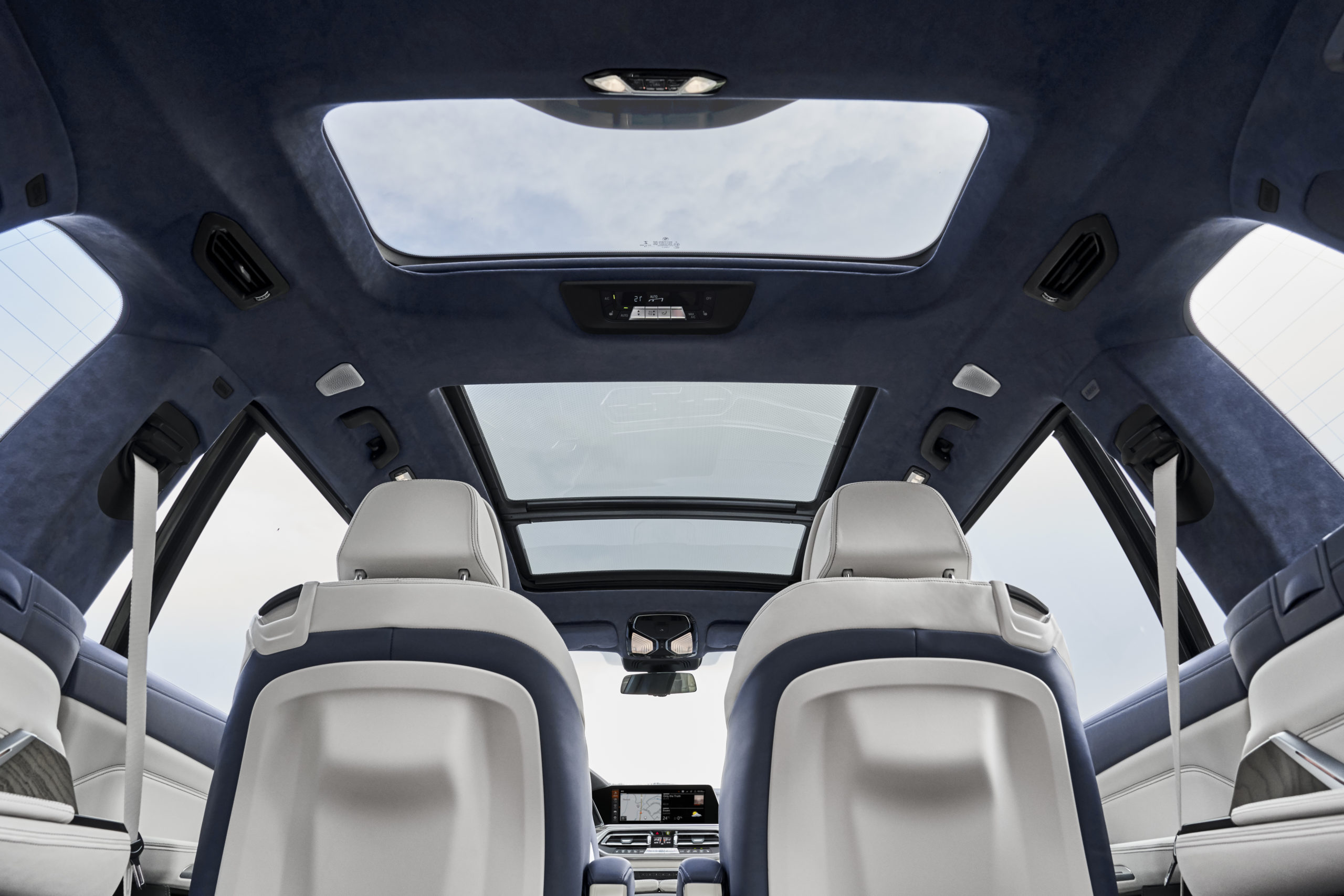
Four-zone automatic climate control is standard, but customers can opt for a five-zone automatic climate control system with separate control panel and additional air vents for the third row of seats. The Ambient Air package that infuses the interior with eight individually selectable scents is optional as is a centre console cupholder that can cool or warm as required. Wireless mobile phone charging in the tray ahead of the cupholders is also standard.
Customers can choose six colour tones and a variety of settings for interior lighting via the iDrive control system. The BMW X7 features the Welcome Light Carpet, which illuminates the entry area to the car when the doors are unlocked or opened. It also features the Dynamic Interior Light that emits pulsating light signals on the inner panelling of an open door when the engine is running and on the instrument panel in response to an incoming phone call.
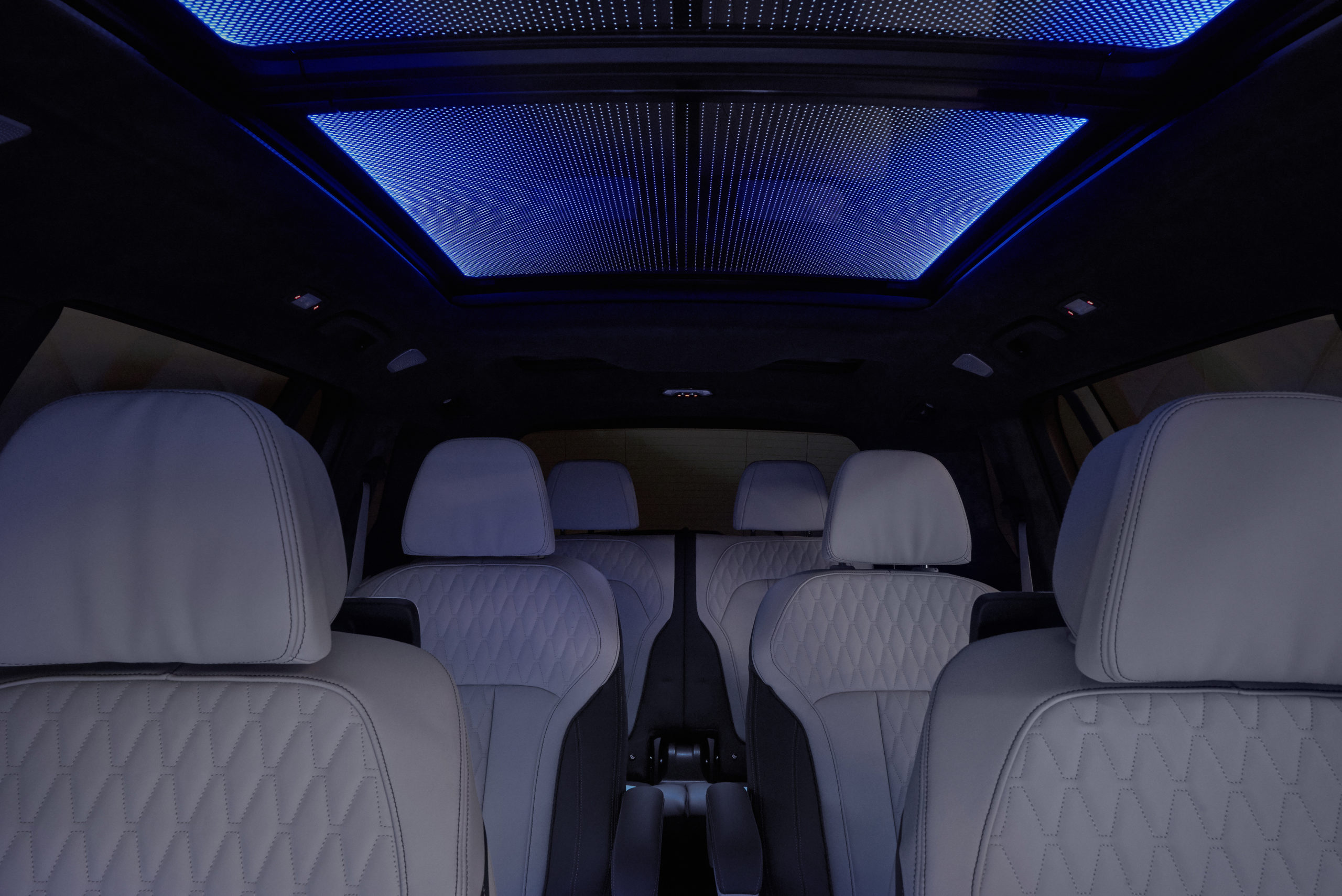
Bespoke interior elements
The luxurious interior features contrast stitching on the seats, trim elements in the colours of M GmbH and design variations for the illuminated door sill plates. The M Sport model also features an M Sport steering wheel, a BMW Individual headliner in anthracite-coloured Alcantara, M-specific detailing for the pedals, driver’s footrest and plus exclusive interior trim strips.
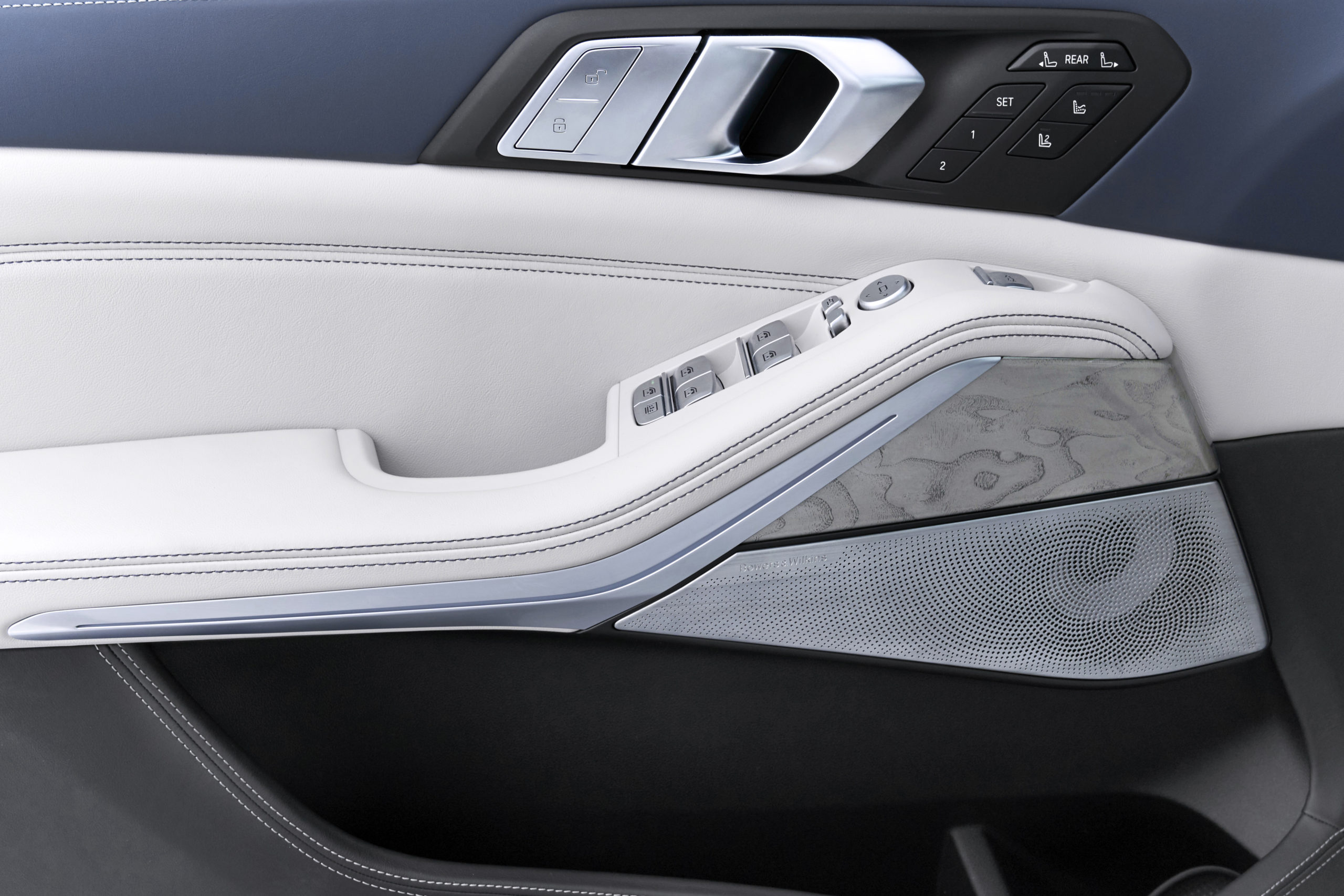
Specially selected options from BMW Individual include extended Merino leather trim which is standard across all variants or optional bi-colour BMW Individual Merino full leather trim in Ivory White/Midnight Blue. BMW Individual fine wood interior trim strips are also available.
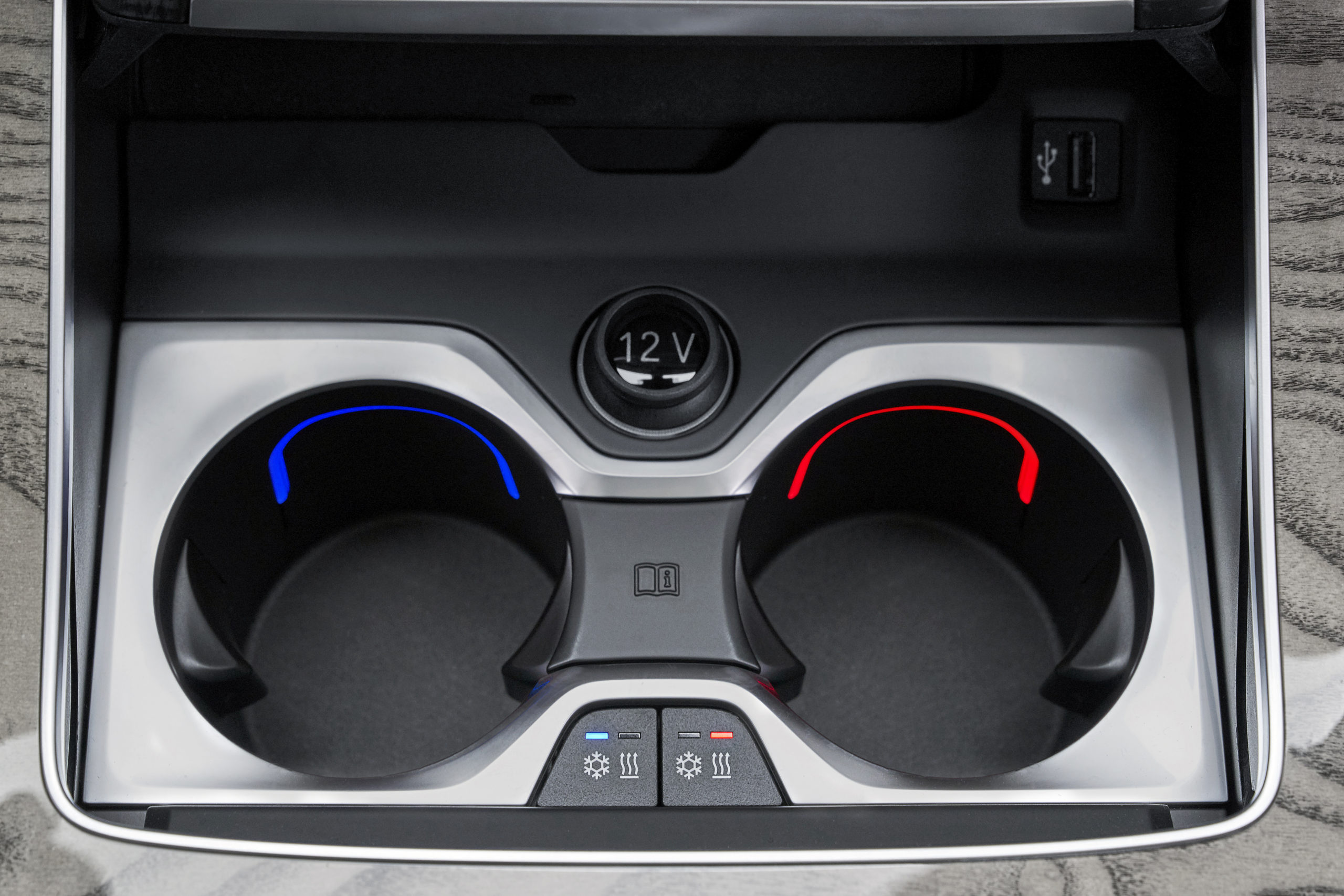
Engines
The engine line-up includes a newly developed a six-cylinder in-line petrol unit for the BMW X7 xDrive40i and a pair of six-cylinder in-line diesels to power the BMW X7 xDrive30d and BMW X7 M50d M Performance models. Petrol and diesel units feature turbochargers and are aligned to eight-speed Steptronic transmission, which has a wider gear ratio spread and new control electronics. This reduces engine speeds, particularly in higher gears, which helps to increase overall efficiency.
|
Model |
Power Output (hp)* |
Peak Torque (NM) |
Acceleration (0-62mph)* |
Top Speed (mph)* |
Fuel consumption combined (mpg)* |
CO2 emissions (g/km)* |
OTR Price from |
|
BMW X7 xDrive30d |
265 |
620 |
7.0 |
141 |
43.5 |
171 |
72,155 |
|
BMW X7 M50d |
400 |
760 |
5.4 |
155 |
40.4 |
185 |
87,240 |
|
BMW X7 xDrive40i |
340 |
450 |
6.1 |
152 |
32.5 |
198 |
74,155 |
*All figures relating to performance, fuel consumption and emissions are provisional
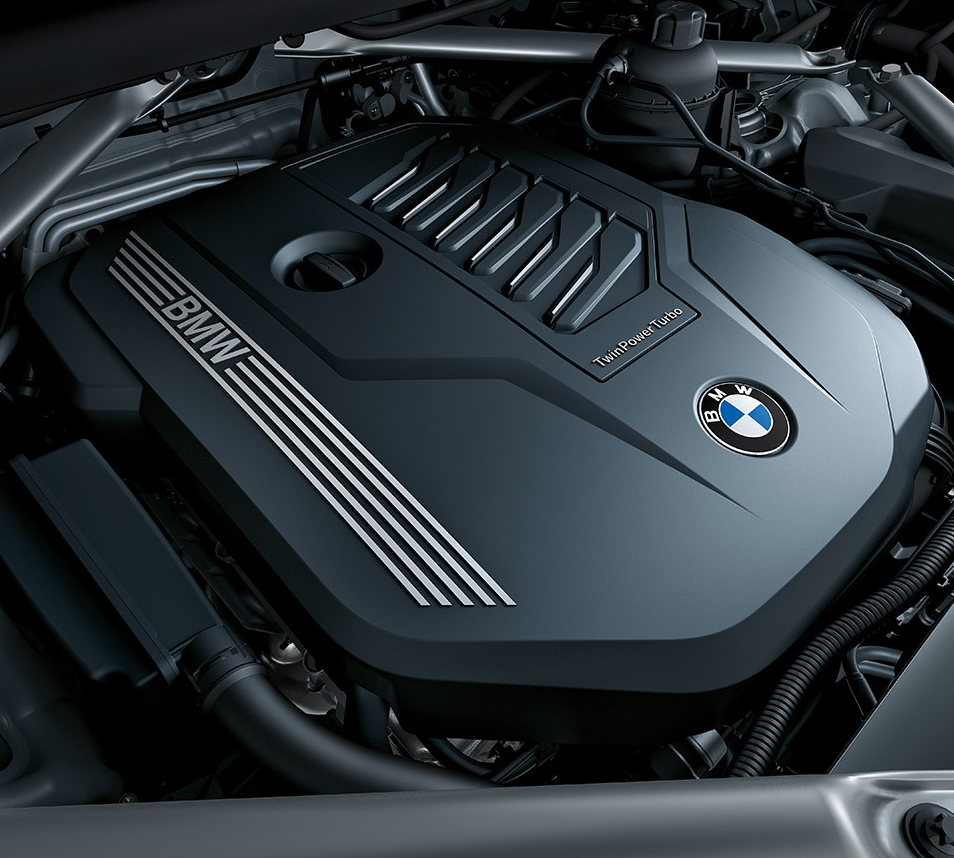
xDrive all-wheel drive with increased efficiency and electronically controlled rear differential lock
The BMW xDrive all-wheel-drive system now varies how the drive torque is split between the front and rear wheels to provide better handling. It links up with Dynamic Stability Control (DSC) and, for added efficiency, full-drive power can be directed to the rear wheels in situations where all-wheel drive is not required, or for more sportier driving.
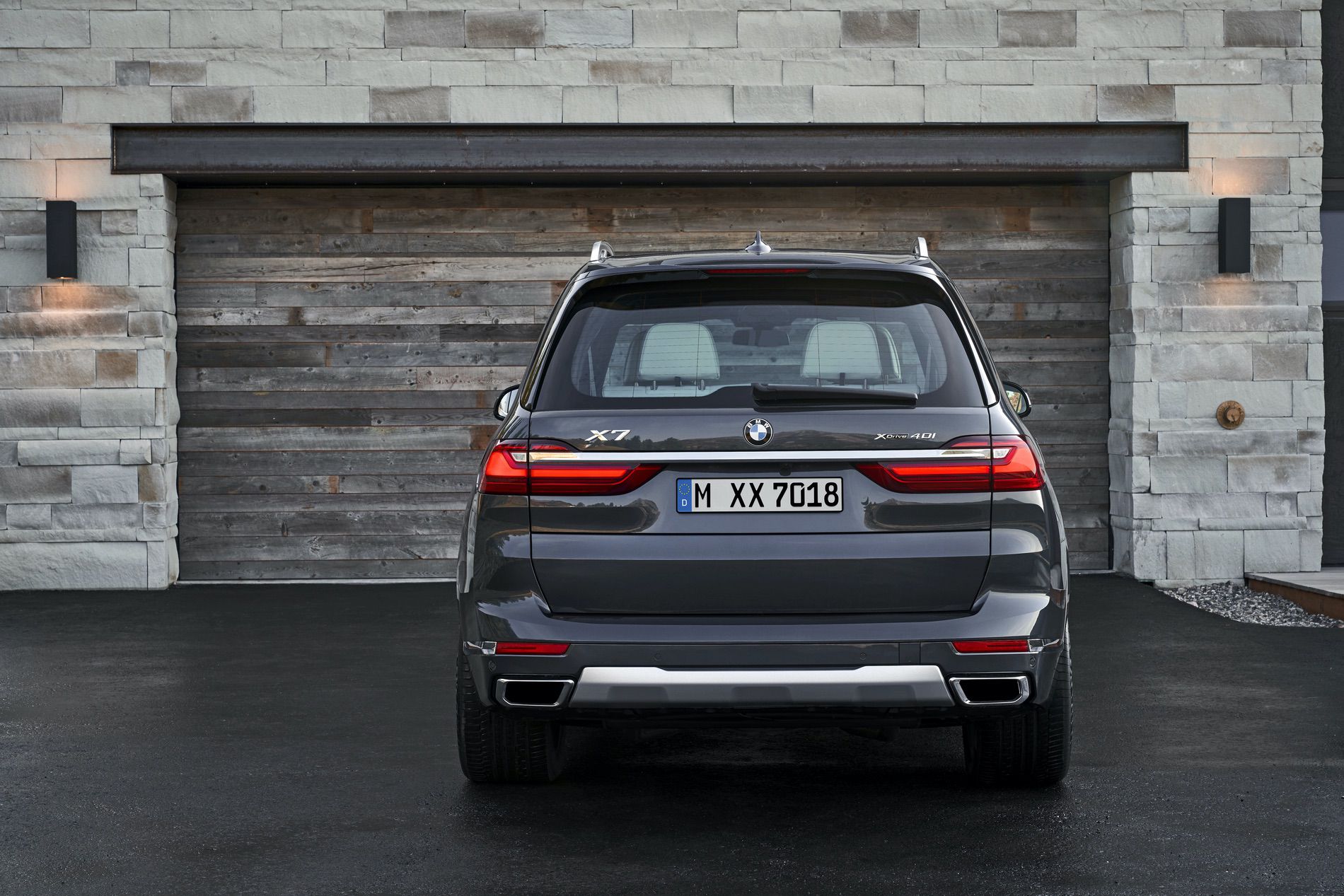
An M Sport differential is fitted as standard on the BMW X7 M50d and in conjunction with the Off-Road package. This electronically controlled rear differential lock also hooks up with the DSC system. This set-up combines to reduce understeer and makes a notable difference when exiting corners. It also increases traction on loose surfaces or roads that require differing levels of grip for the left and right rear wheels.
Chassis technology
The chassis of the BMW X7 features a double-wishbone front axle and a five-link rear axle combination to provide maximum ride comfort and agile handling. Ride comfort is further enhanced by its two-axle air suspension with standard-fit automatic self-levelling. The new BMW X7 M50d features the M Sport differential, exclusive 22-inch M light-alloy wheels finished in cerium grey and a model-specific chassis set-up. When SPORT mode is engaged, or the car’s speed exceeds 86mph, the ride height is automatically lowered by 20mm.
The driver is also able to adjust the body’s ground clearance – for off-road driving, for example – by pushing a button in the cockpit to raise it in two stages up to 40mm above the standard setting. Another button in the luggage compartment activates a loading mode that lowers the car by 40mm. The next time the engine is started, the system will automatically revert to the last mode selected. The ride height can also be set with the engine switched off using the buttons in the car or the optional BMW Display Key.
Integral Active Steering is available as an option. By turning the rear wheels in either the same or the opposite direction as the front ones, it offers nimble cornering and effortless lane changes. It is particularly useful in city traffic and when parking in tight spots.
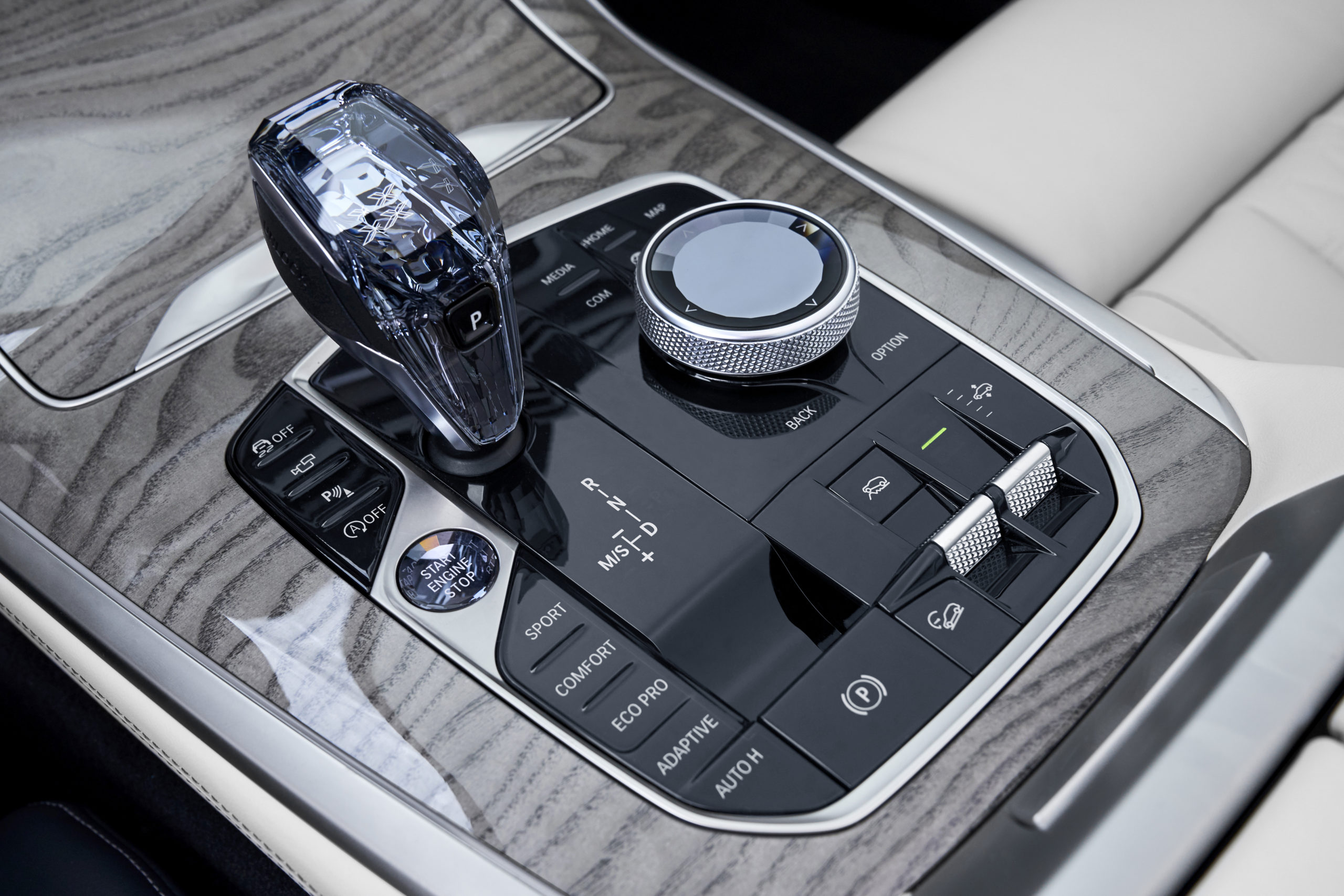
Customers can select the Executive Drive Pro option, which adds active roll stabilisation for assured handling and has the added effect of increasing straight-line driving comfort by countering the vibrations triggered by bumps on one side of the road.
The Off-Road package is available for all model variants apart from the BMW X7 M50d and it features its own special graphics in the instrument cluster and Control Display, as well as an extra button on the centre console for selecting four driving modes – xSnow, xSand, xGravel and xRocks.
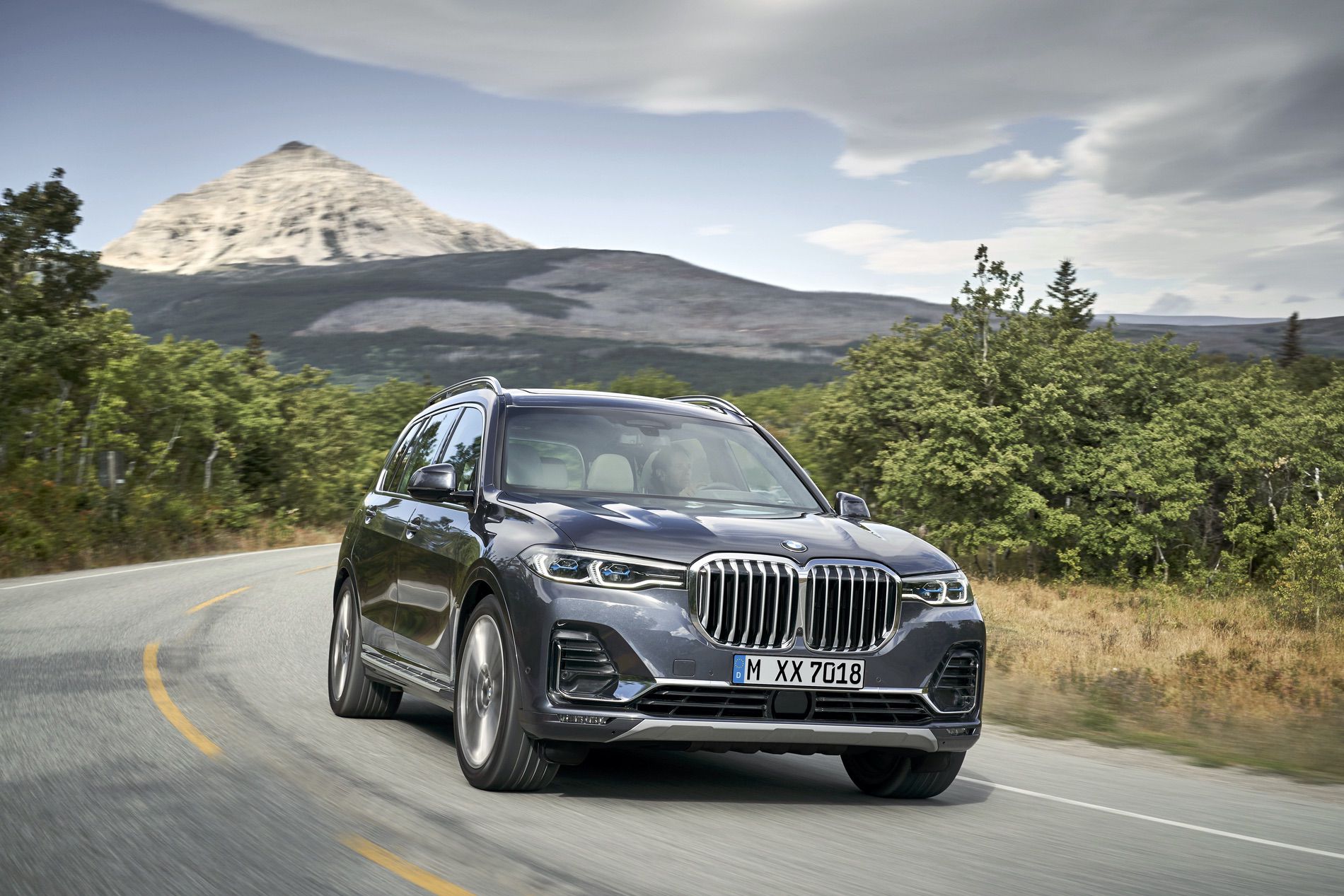
The package also includes Lane Change Assistant, which is activated by using the indicator stalk. Another component of the system is the evasion aid, which can help avoid collisions with vehicles or pedestrians suddenly appearing in the driver’s path by helping the driver direct the vehicle into a clear adjacent lane with steering inputs.
Another feature is Crossing Traffic Warning, which reduces the risk of a collision when manoeuvring forwards, or in reverse, towards crossing traffic where visibility is restricted. Rear Collision warning, Priority warning, Wrong-way warning and Lane Change Warning also form part of the Driving Assistant Professional package. The latest version of Lane Departure Warning now includes active steering inputs to bring the vehicle back into the intended lane.
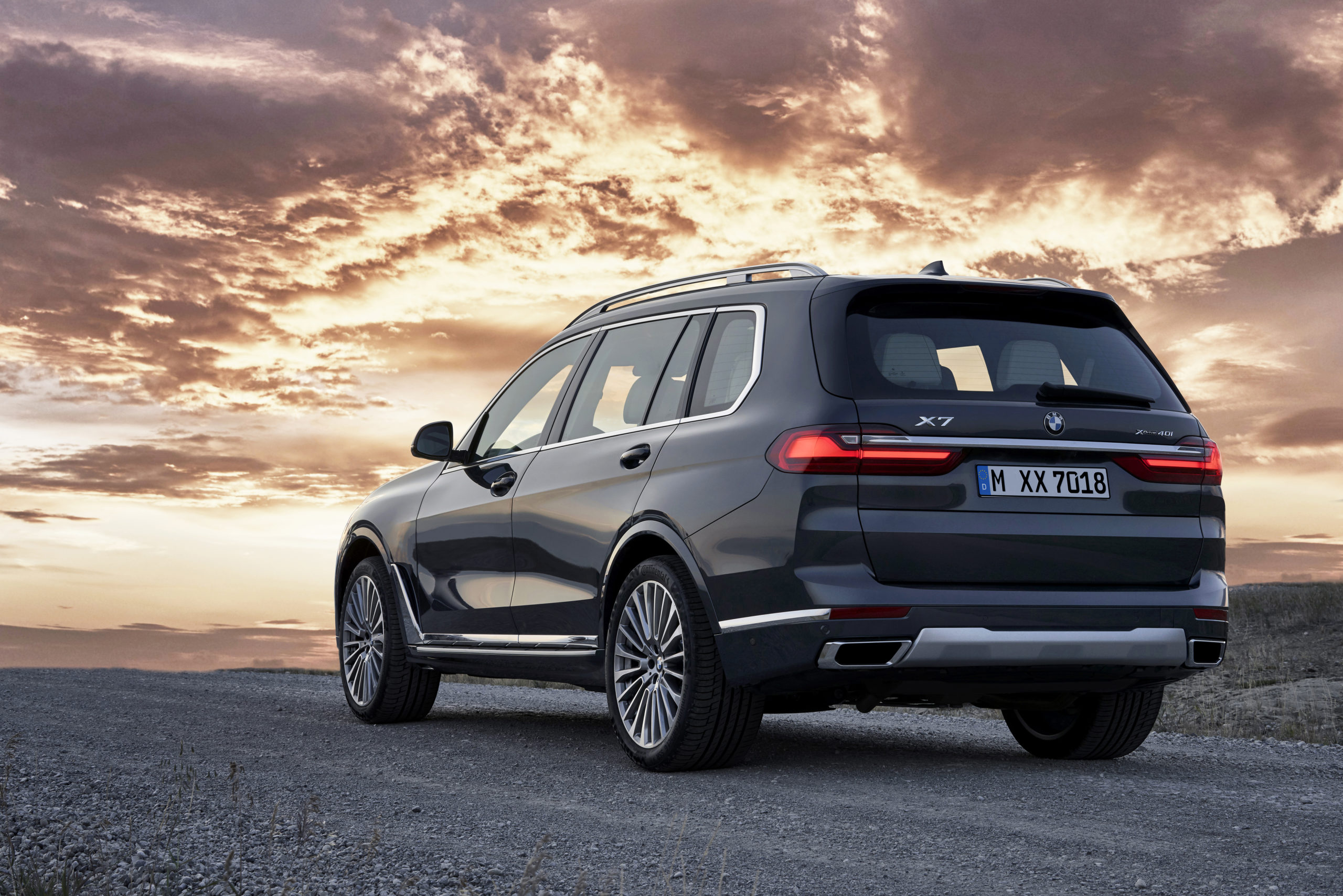
Another system available within this package is Reversing Assistant, which offers automated reversing in confined spaces such as in multi-storey car parks or entrances to courtyards. It can reverse the vehicle for distances of up to 50 metres by steering it along the same line it took when moving forward: all the driver has to do is operate the accelerator and brake pedals with speed limited to 5.5mph. The steering movements made during the vehicle’s last forward manoeuvre are stored and retained, even for longer periods. This means the Reversing Assistant can be used to manoeuvre the new BMW X7 backwards out of a parking position that it drove into forwards the preceding day, for example.
BMW Connected and ConnectedDrive
Standard equipment on the X7 includes the BMW Intelligent Personal Assistant, a digital helper that responds to the prompt “Hey BMW”. The BMW Intelligent Personal marks the start of a new era in which drivers will increasingly be able to operate their car, access its functions and obtain information simply by speaking. Updates to this system will be continuous and can be made on a smartphone and in-car via the Remote Software Upgrade functionality.
The BMW Intelligent Personal Assistant learns routines and learns the driver’s preferences such as seat heating settings or the places they navigate to frequently (“Take me home”). Unlike other systems, the driver can give the assistant a name, and it can even provide casual conversation. Saying “Hey BMW, I’m cold” will prompt the BMW Intelligent Personal Assistant to adjust the temperature inside the car accordingly. The assistant gets better with every command given, every question asked and every setting made.
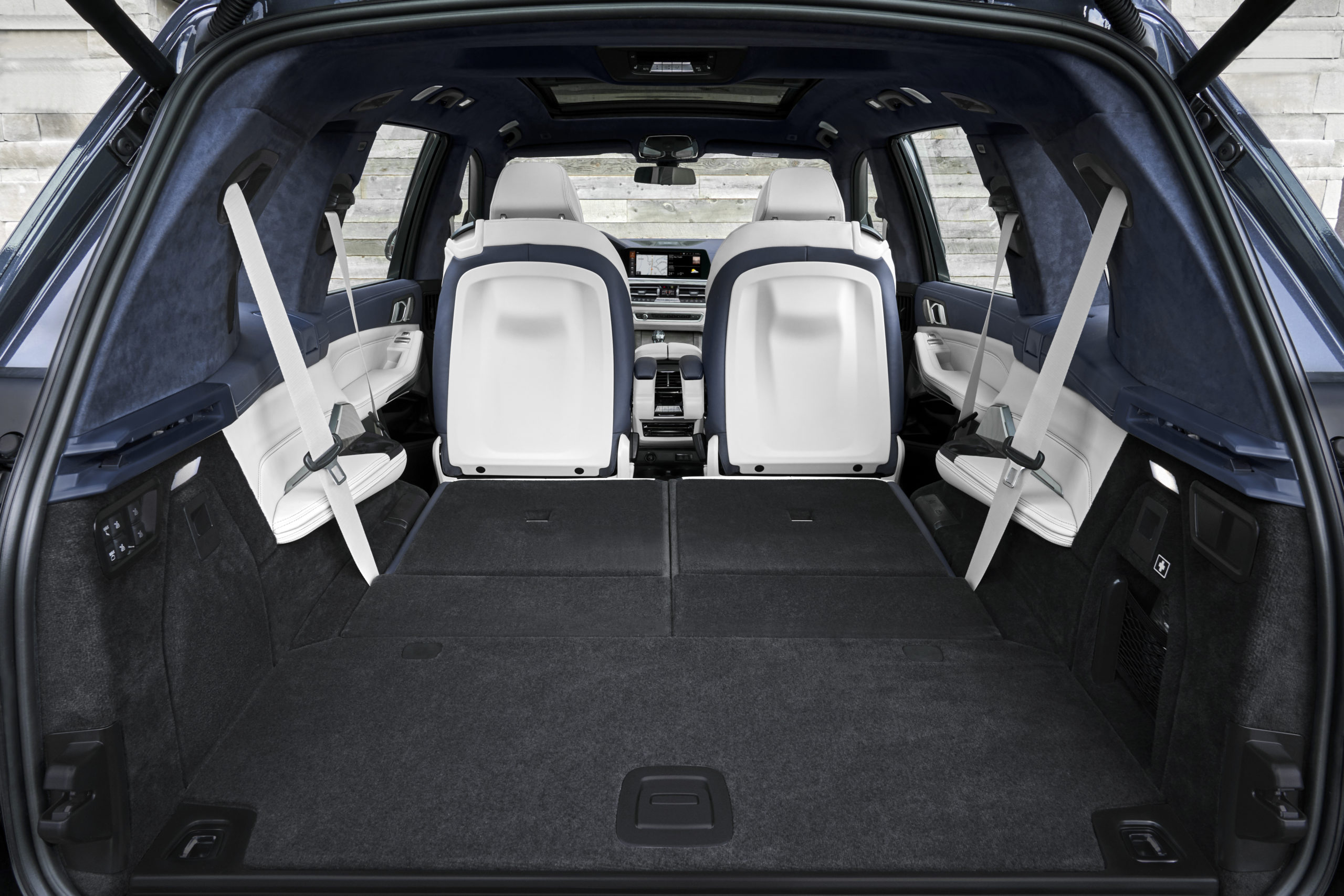
The BMW Intelligent Personal Assistant is also able to explain all sorts of different functions, for example “How does the High Beam Assistant work?”, it can provide status updates of the car with regards to fuel and oil levels and help to answer a range of other questions. It can even activate a range of functions to enhance well-being. For instance, “Hey BMW, I feel tired” triggers a programme that adjusts the lighting mood, music and temperature to make the driver feel more awake.
BMW Digital Key
The BMW Digital Key employs Near Field Communication (NFC) technology to allow the BMW X7 to be locked and unlocked from a compatible smartphone. Holding the smartphone up to the door handle opens the car and, once inside, the engine can be started as soon as the phone has been placed in the wireless charging or smartphone tray. Accessible via the BMW Connected app, the Digital Key offers unrivalled flexibility as the driver can share it with up to five other people. The BMW Digital Key is available for NFC-capable Samsung Galaxy smartphones running Android 8.1 and above. Alternatively, customers can use the BMW Key Card which is supplied with the car.
Connected Navigation
Connected Navigation offers a range of digital services to make route planning both in the car and away from it, much easier. With this new technology drivers can send destinations from the BMW Connected app straight to their car’s navigation system and the most important destinations will be stored, meaning important addresses can be accessed from any device at any time. A new feature is the Parking Space Assistant, which proposes various parking options to the driver in good time before the destination is reached. This service includes providing information on the nearest multi-storey car park as well as proposing routes offering a good chance of finding a parking spot close to the destination. The existing On-Street Parking Information has also been incorporated into the scope of functions that form Connected Navigation.
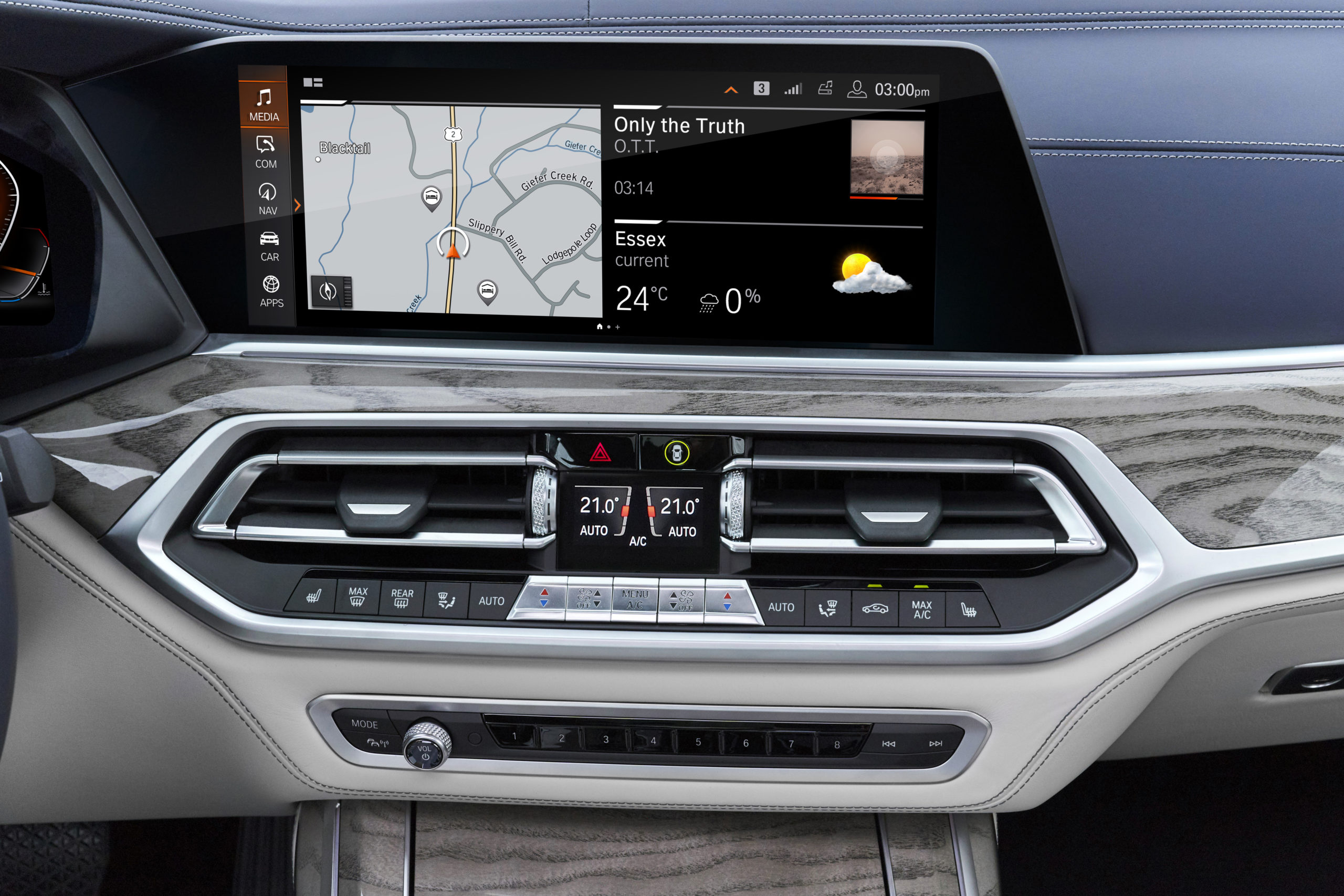
BMW Operating System 7.0 display and control concept
The all-new instrument cluster and Control Display is designed to help drivers concentrate on the road ahead. The BMW Live Cockpit Professional, fitted as standard, comprises a fully digital, high resolution information display behind the steering wheel and a Control Display that each have a screen diagonal of 12.3-inches. This package also features an adaptive navigation system and a hard-drive-based multimedia system with 20GB of memory.
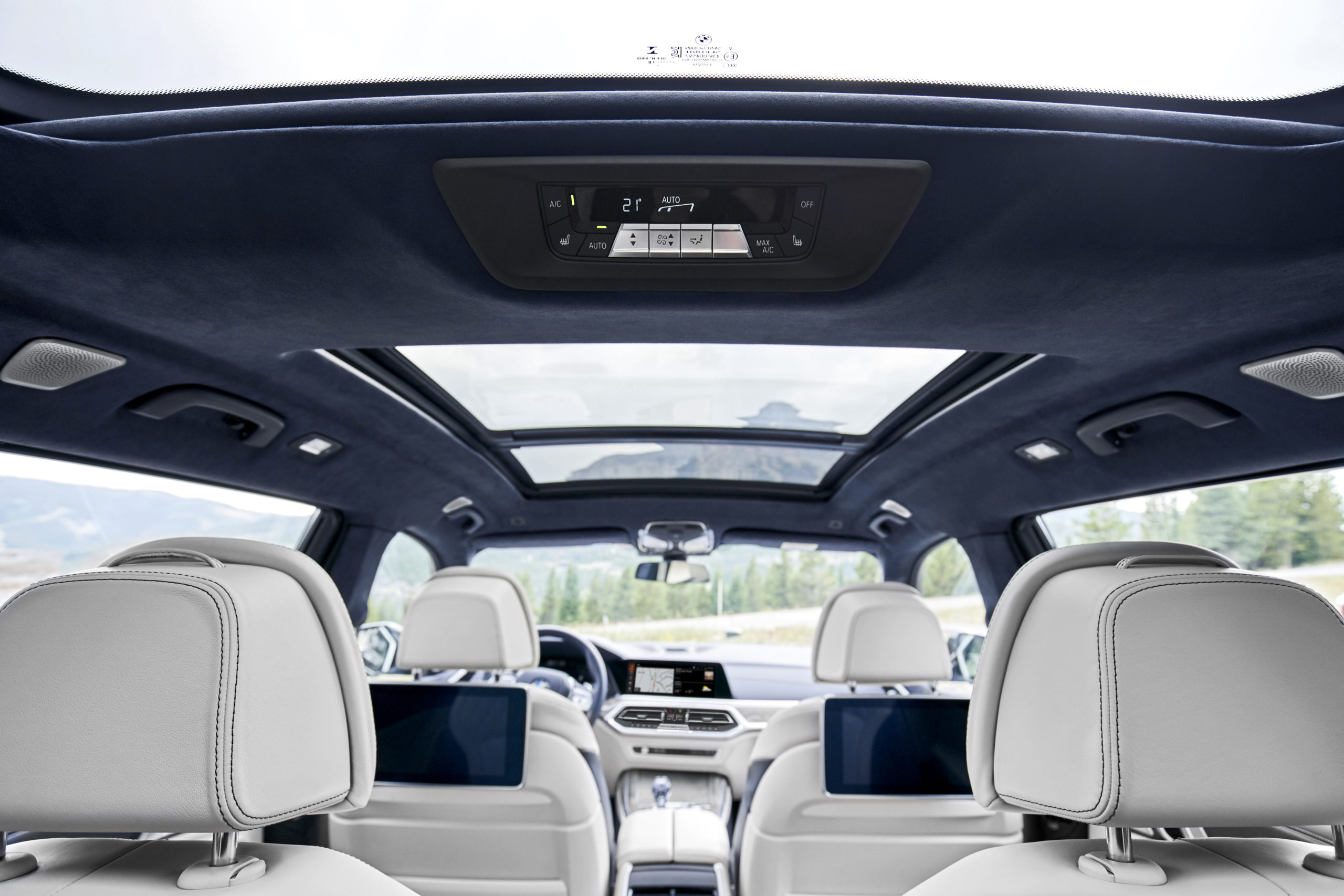
BMW Live Cockpit Professional drivers get all the benefits of the new BMW Operating System 7.0, which offers drivers more ways to customise the system to their own preferences: even the vehicle mock-up on the display matches the model colour and equipment line.
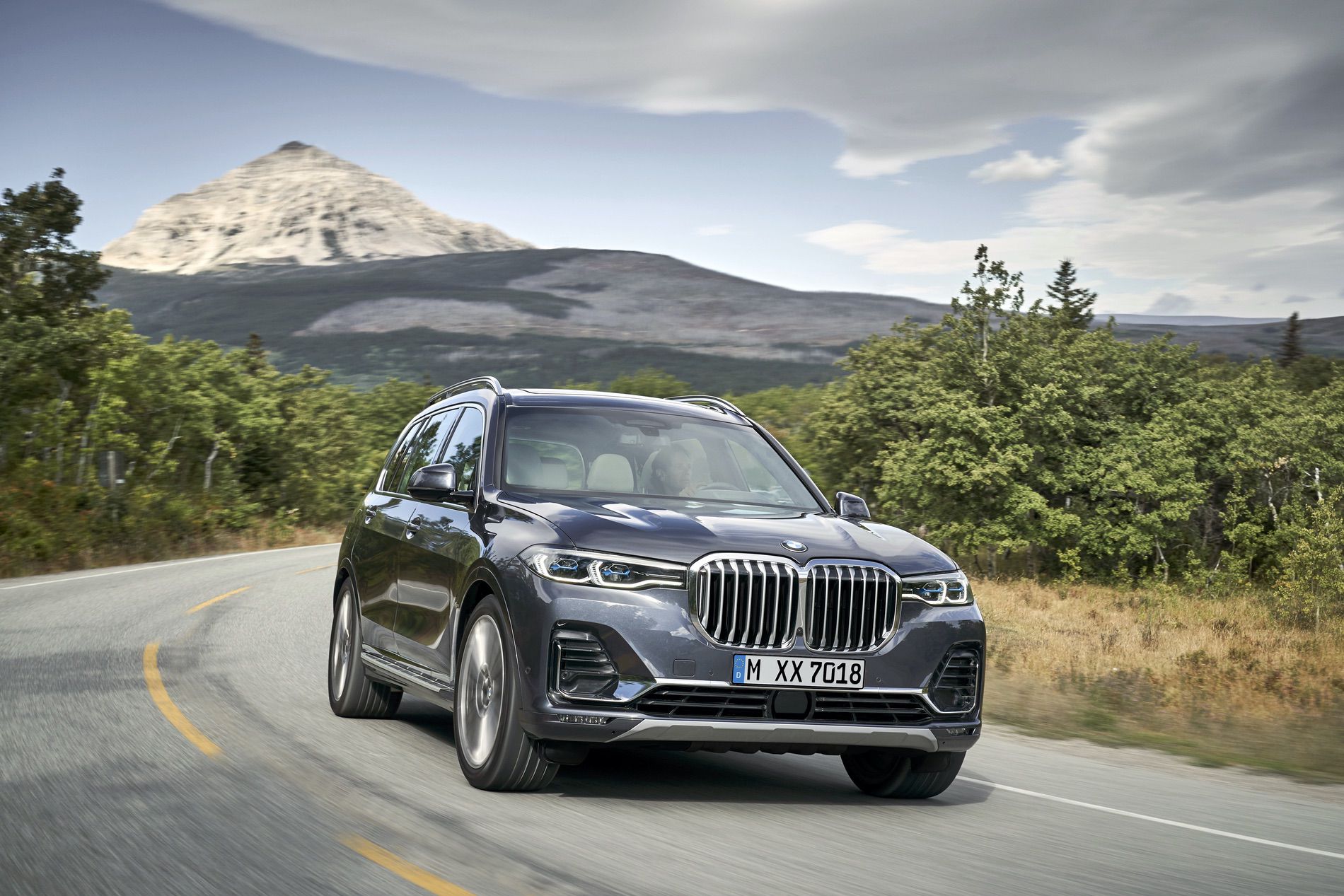
The BMW X7 will go on sale from April 2019, with OTR prices starting from 72,155.
BMW X7 vs. BMW X5 – Comparison
Source: bmwblog.com
Some of the first reactions we received after posting the BMW X7 were mocking it for being too similar to the BMW X5. The X7’s …
Some of the first reactions we received after posting the BMW X7 were mocking it for being too similar to the BMW X5. The X7’s lesser sibling debuted a few months ago and it immediately became a fan favorite, as its looks, tech and driving dynamics make it one of the best Bimmers in a long time. Still, it’s not as if fans want to see BMW’s most expensive SUV looking almost identical to a car that costs far less.
So we decided to take a look at both cars back to back, to see just how similar, or dissimilar, they are. To be honest, though, while both cars share the same new design language, they’re not identical. Also, all brands share design languages across models, so it’s a bit unfair to slam the X7 for that. Still, let’s take a look at the two cars.
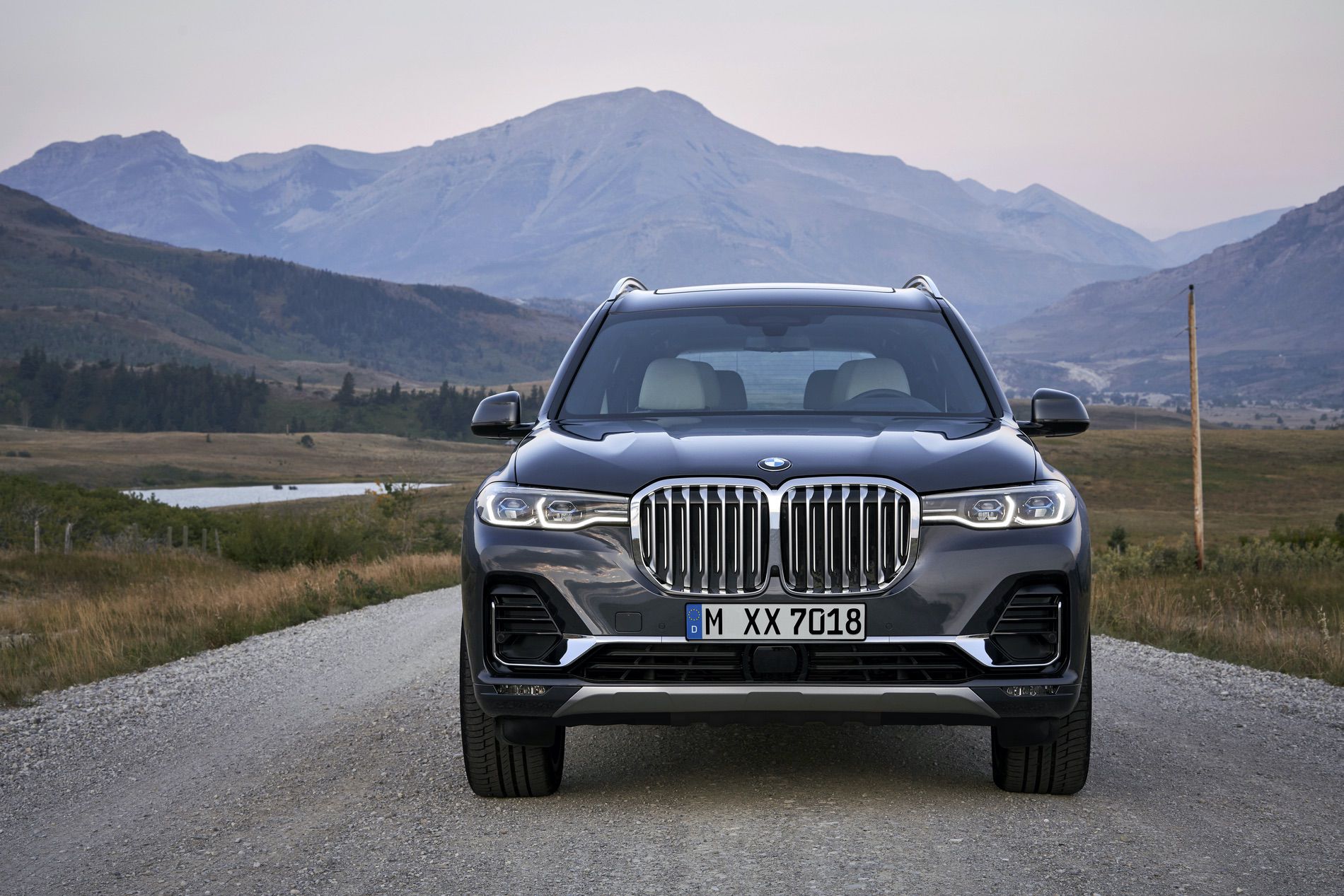
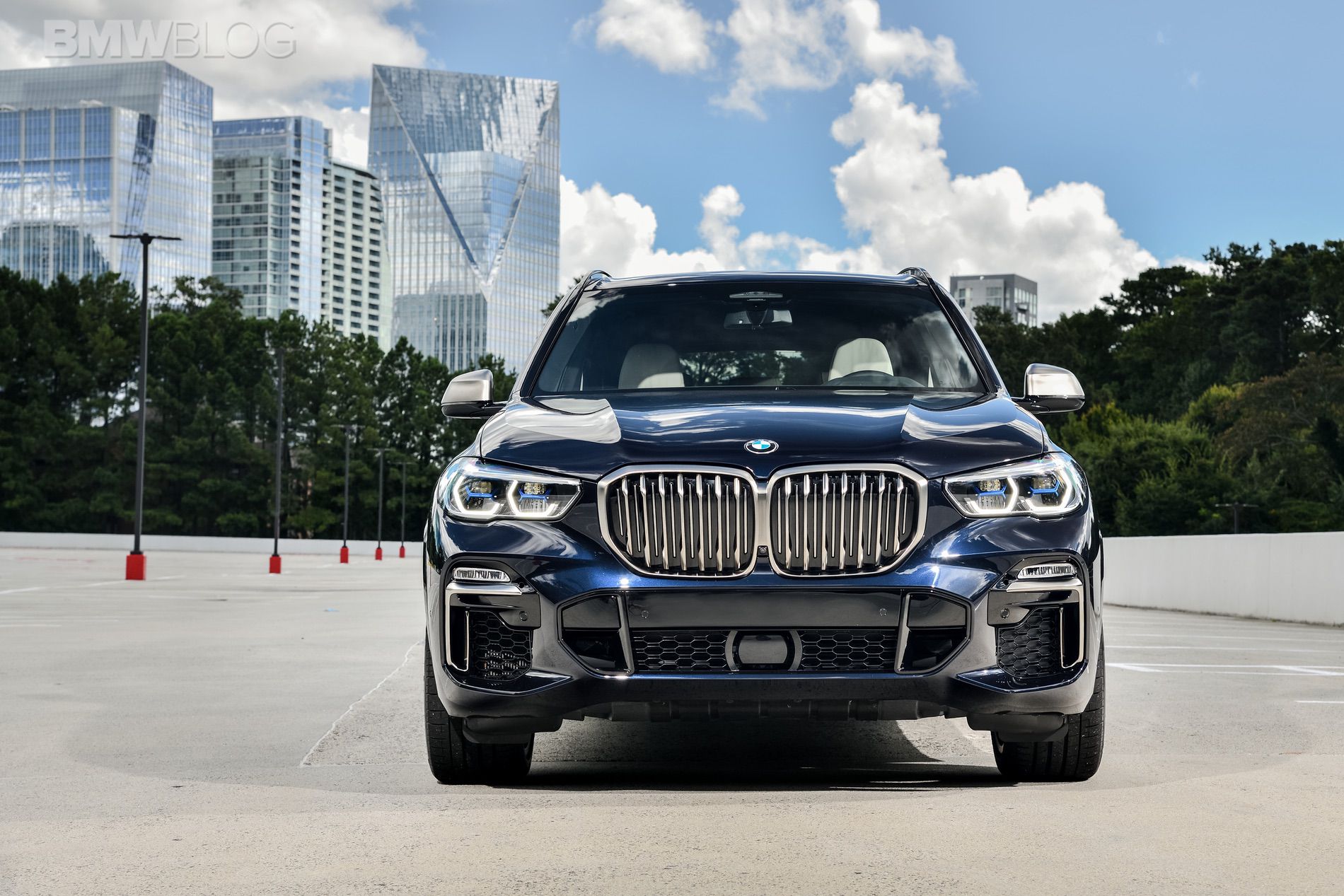
From the front, these two are admittedly similar. There are differences, of course, with the X7’s Kidney Grilles being significantly larger and its headlights quite a bit slimmer, but their lineage is obvious. Though, the headlights on the X5 don’t actually connect to the grilles, even though the do get close, which helps to separate the two, even if it’s just by a bit.
The BMW X5 is the more handsome car up front, though. It’s less cartoonish, less like a caricature, than the X7 is. It’s also far sportier, the X5, looking more athletic, even from the front.
Out back, they look less similar. Obviously, the rear of the BMW X7 sports a silver trim bar that spans the width of the tailgate and its headlights are basically upside-down versions of the X5’s. Look deeper, though, and you’ll notice the X5 is a bit more muscular and a bit sportier. It also seems to get steeper departure angle at the back, making it a bit more adept at tackling some rough pavement. Though, neither of these are genuine off-roaders.
In profile, the BMW X5 is sportier and tougher looking. Its wheel arches are more flared, its shoulder line more pronounced and its roofline is a bit more aggressive. While the BMW X7 is taller, more slab-sided and has a roofline that extends nearly straight, all the way to the ass end of the car, so as to accommodate third-row passengers. The X7 looks like the more practical car because it is.
On the inside, the complaints about their similarity are most warranted. The BMW X7’s cabin looks a bit like a copy-past-enlarge job. While it’s still a great looking cabin, it’s just essentially an X5’s interior that’s been enlarged a bit. Some materials will be nicer, sure, but the design is largely the same. Even the stitching on the dash is the same. For the brand’s flagship SUV, BMW could have put in more effort than that.
